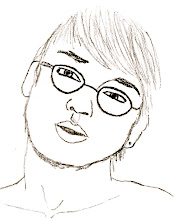
Illumination can mean several things. I can mean highlighting an item of idea that is important. Also it can mean to light something up with any light source. In classes thus far, we have "illuminated" several things. For the Illuminated Objects project, Suzanne had us draw five objects that are meaningful to us. I decided to draw my boyfriend, a bracelet, my Gameboy a stuffed dog and a plastic hamburger. Also, more recently, we have been learning to use watercolors. A big point that Suzanne has stressed is to try to capture light when painting to add more visual depth and interest to a picture.

Idioms, to me, are a type of inside joke. They are items that have a meaning beyond the skin. The fairy tales that we have been reading are meant to be idioms and our task has been to discover what they're deeper meanings are. In Sweatheart Roland, the moral of the story seems to be that Love Conquers All. The main characters have to flee from the wicked stepmother or else be killed. Much of the focus is on their adventures but, if you dilute the story into a broad generalization, you realize what the author was trying to tell you all along.
Materials have been popping up all over the place! In studio, we have been working with chip-board for the first time. Also, we are working with light woods, balsa and bassawood, to make models. And to dig up a dead horse for another beating, we will once again be working with concrete to finish up our project from last semester. In Patrick's history class, another turn has been taken. In the images that he's been sharing, we've seen different examples of civilizations using indigenous and transported materials for their structures. In the case of Stonehenge, rocks were imported over a long distance. In Egypt, however, structures such as temples and the Great Pyramids implement local materials. In these instances, the buildings blend in more with their surroundings, but without taking away from the buildings' uniqueness.
Commodity determines the function of a design. It explains how a space should be viewed, used and laid out. Stoel gave us the assignment to design a unit of furniture for a Mr. Pat that would serve as a chair, work bench, table and a server. The stipulations we had were that all pieces had to be attached and they all had to be cut from one piece of wood. In my final product, I have a chair and a table top that can be used for eating, working and serving. I also included several shelving spaces and even a foot rest in the table leg.
Firmness is greatly personified by the Ancient Egyptians. Firmness refers to how structurally sound something is. THe Ancient Egyptians were experts of firmness, considering how much stock they put into the idea of permanence and the afterlife. Many of their greatest structures are still around, such as the Pyramids of Giza and many other temples and tombs. Another lesson we have learned in firmness is of the structures at Stonehenge. These mysterious post-and-lintel constructs have withstood the test of time with the simplest of designs.

Delight is the easiest to comprehend of the wonderful trifecta of Commodity, Firmness and Delight. Delight refers to all the elements of design, coming together in a pleasing way. In design t deals with anything, ranging from color and contrast to lighting, texture and space. As a design student, delight is a very important thing. It is important to learn new techniques and also use old ones to come up with unique, interesting compositions that catch a viewer's eye and engages them.

No comments:
Post a Comment